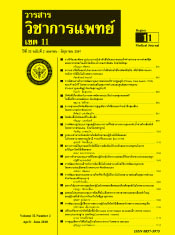Dengue In Infancy
Keywords:
Dengue infection, infancyAbstract
Introduction: Dengue virus infection is a major public health problem in Thailand and most countries of the world. It has a many varieties of clinical manifestations ranging from self-limited illness to fulminant course resulting to death. Most dengue virus infection in infant have asymptomatic. However, severe dengue also occurs in infants. Prompt recognition of dengue is important for appropriate case management, particularly in infants whom febrile illness from other causes is common.
Objective: To assess the clinical manifestations of dengue infection in infants.
Patients and Methods: A retrospective descriptive study was performed by reviewing the medical records of dengue patients aged 0-2 years admitted in Chumphon Khet Udomsak Hospital from January 1, 2014 to December 31, 2017. The diagnosis of dengue patients adhered to World Health Organization dengue definition and classification.
Result: 32 under 2 years old dengue patients (males : females ratio was 1:1) were hospitalized to Chumphon Khet Udomsak Hospital during the study period. All of these were classified to Dengue Fever (DF) 53.1%, Dengue Hemorrhagic Fever (DHF) 40.6% and Dengue Shock Syndrome (DSS) 6.3%. The average age of the patients was 12.4 months and the youngest patient was 5 day old. The clinical features presented with fever (100%), positive tourniquet test (72.3), skin rashes (46.7%) coryza and diarrhea (43.8%), cough, vomiting and anorexia (37.5%), hepatomegaly (30.3%) drowsiness (28.1%), convulsion (12.5%), respiratory distress (6.3%) and neonatal jaundice ( 3.1%).
The mean values of the complete blood count (CBC)
parameters included minimum white blood cell count were 5,011.5/mm3 (maximum percent of atypical lymphocytes, lymphocytes and neutrophils were 2.7 %, 68.3 % and 20.7 %, respectively.) maximum hematocrit concentration were 37.6 % and minimum platelet count were 54,221/mm3. The mean values of liver function test (LFT) was shown maximum AST 426.1 U/L, maximum ALT 147.6 U/L and maximum ALP 170.3 U/L. There was no mortality.
Conclusion: The dengue patients in this study had dengue fever and Dengue hemorrhagic fever in a similar ratio. Common symptoms were fever, positive tourniquet test, skin rashes, coryza, diarrhea, cough, vomiting, anorexia, hepatomegaly, drowsiness, convulsion, respiratory distress, and neonatal jaundice. Hepatic involvement in dengue presents with elevated transaminases.
References
: New Delhi: WHO; 2001.
ศิริเพ็ญ กัลยาณรุจม, มุกดา หวังวีรวงศ์, วารุณี วัชรเสวี. การวินิจฉัยและรักษาโรคไข้เลือดออกเดงกี. พิมพ์ครั้งที่ 3. กรุงเทพฯ:กระทรวงสาธารณสุข; 2559.
Jain A, Chaturvedi UC. Dengue in infants: an overview. [Internet]. 2010 [cited 2018 Apr 23]. Available from:http://www.ncbi.nlm.nih.gov/pubmed/20402771
กองควบคุมโรค. สำนักระบาดวิทยา. สำนักโรคติดต่อ. สถานการณ์โรคปีปัจจุบัน. [เข้าถึงเมือ 23 เมษายน 2561]. เข้าถึงได้จาก:http://www.boe.moph.go.th/boedb/surdata/disease.php?ds=66
Ahmed A., Keeffe EB. Liver Chemistry and function tests. In: Feldman M, Friedman LS, Brandt LJ, editors. Feldman: Sleisenger & Fordtran’s gastrointestinal and liver
disease. 8th ed. Philadelphia: Saunders Elsevier; 2006. p.1575-86.
Aphikulchatkit Y. Vertical transmission of dengue infection in Thai preterm infant. Thai J Pedriatr 2014;53:144-8.
Pothapregada S. Neonatal dengue infection [Internet]. 2017 [cited 2018 Apr 23]. Available from: http://www.indian-pediatrics.net/dec2017/1058.pdf
Wang SM, Sekaran SD. Early diagnosis of dengue infection using a commercial dengue duo rapid test kit for the detection of NS1, IGM, and IGG. Am J Trop Med
Hyg 2010;83:690-95.
Tiawilai A. Deugue during Infancy. Thai J Pedriatr 2013;52:56-60
Bich Chau TN, Anders KL, Lien LB, Hung NT, Minh Hieu LT, Tuan NM, et al. Clinical and Virological Features of Dengue in Vietnamese Infants. PLoS Negl Trop Dis [Internet]. 2010 [cited 2018 apr 23]; 4(4): e657. doi:10.1371/ journal.pntd.0000657. Available from:http://journals.plos.org/plosntds/article?id=10.1371/journal.pntd.0000657
Capeding RZ, Brion JD, Caponpon MM, Gibbons RV, Jarman RG, Yoon IK, et al. The Incidence, Characteristics, and Presentation of Dengue Virus Infections during Infancy. Am. J. Trop. Med. Hyg 2010;82(2):330–6.
Pothapregada S, Kamalakannan B, Thulasingham M, Sampath S. Clinically profiling pediatric patients with dengue. J Glob Infect Dis 2016;8:115-20.
Thisyakorn U, Thisyakorn C. Dengue with central nervous system involve- ment. Southeast Asian J Trop Med Public Health 2015;46:118-22.
Singh L, Singh A, Agarwal M, et al. Is dengue emerging as important cause of acute liver failure in endemic regions? World J Clin Cases [Internet].2017 [cited 2018 Apr 23]. Available from: https://www.ncbi.nlm.nih.gov/ pmc/articles/PMC5530800/






